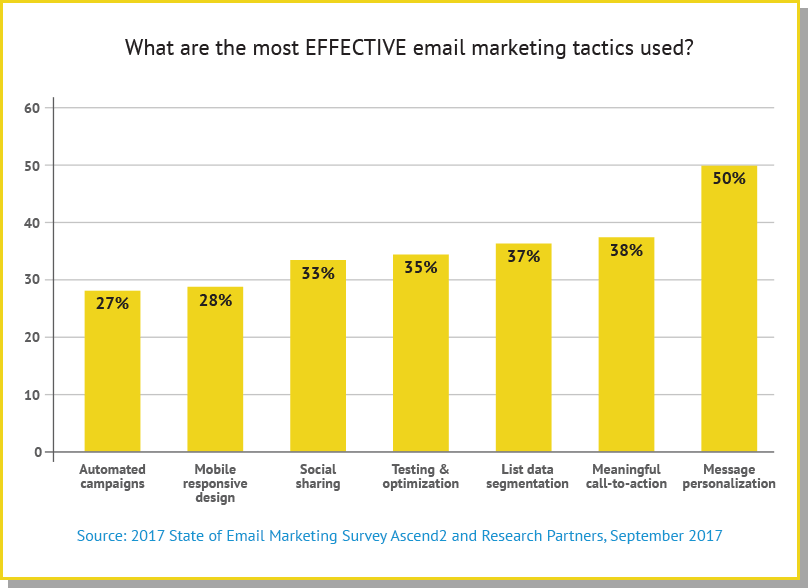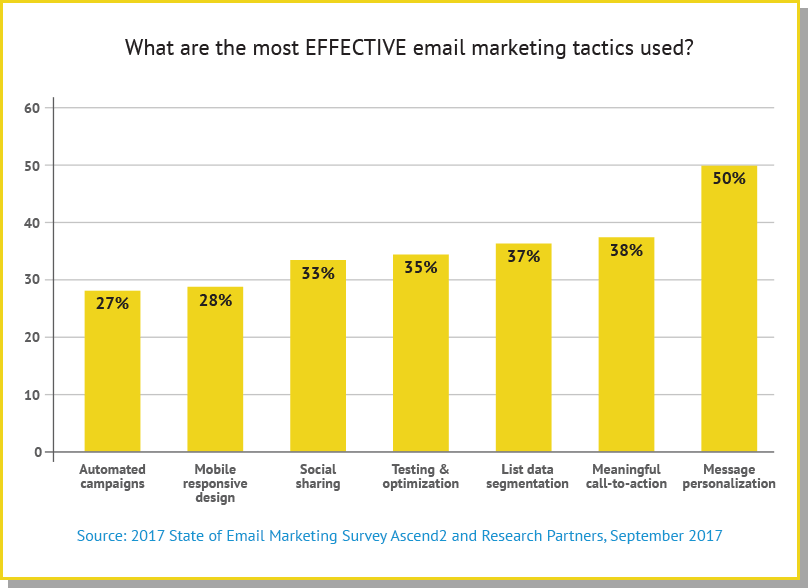With GDPR on the horizon, email marketing expert Kevin George takes a look into how you can personalize your email strategies for better engagement while avoiding the spammy tactics that GDPR is designed to prohibit.
In an age of information overload, email marketing can be a powerful tool for your local business. Considering the more limited area local businesses cater to and the competitive bottleneck in the marketplace, email marketing can bring more conversions, and is fast emerging as a winning channel when it comes to ROI. To make your email marketing efforts pay off, it’s worthwhile incorporating personalization in your email marketing strategy.
But don’t just take my word for it; we have statistics to back this up!

Let’s take a good look at how local businesses can drive growth by employing simple personalization tips.
Improve your Segmentation Strategy
Proper segmentation is the key to effective personalization. Local businesses can segment based on the subscriber’s demographics, past purchases, and email activity.
By segmenting your lists, you can send out more relevant content that suits your buyer’s needs and engages them better. The stages of the buyer’s journey (awareness, consideration, and decision) should also be considered while segmenting.
Here are some different ways marketers can segment their email lists.
Demographics
Age, gender, and geographic location play an important role in influencing buying habits.
List of Generations
| Generation Name | Births Start | Births End | Youngest Age Today* | Oldest Age Today * |
|---|---|---|---|---|
| The Lost Generation / The Generation of 1914 | 1890 | 1915 | 103 | 128 |
| The Interbellum Generation | 1901 | 1913 | 105 | 117 |
| The Greatest Generation | 1910 | 1924 | 94 | 108 |
| The Silent Generation | 1925 | 1945 | 54 | 72 |
| Baby Boomer Generation | 1946 | 1964 | 54 | 72 |
| Generation X / Baby Bust Generation | 1965 | 1979 | 39 | 53 |
| Xennials | 1975 | 1985 | 33 | 43 |
| Millennials / Generation Y / Gen Next | 1980 | 1994 | 24 | 38 |
| iGen / Gen Z | 1995 | 2012 | 6 | 23 |
| Gen Alpha | 2013 | 2025 | 1 | 5 |
*if still alive today
Note: This is a tentative list, so some overlap in dates is inevitable (Source: www.careerplanner.com)
Age
If your email list consists of Gen Z, they would be more interested in knowing about the latest gadgets and technology when compared to the Baby Bust generation. Segment your list based on generational data to ensure you’re targeting the right audience with the right content.
Gender
For local businesses and agencies dealing with gender-specific products or services, gender-based segmentation can come in very handy for you.
Location
Segmentation based on geographic location can help you send out emails specific to store branches (in the case of multi-location businesses) and promote offers suited to those locations. You can also tie your marketing messages in with local events using location segmentation.
Subscriber Activity
Create relevance based on the actions of your subscribers by looking at the pages they visit, the products or services they look for, the content they download, and their purchase habits.
For example, if you’re a performing digital marketing for a dentist, it would be a good idea to target your subscribers based on the kind of treatment they have searched for, or maybe the symptoms they have selected on your website. You can even promote specific discount offers based on their searches.
Email Activity
Analyzing email clicks (amount and content clicked on) lets you gauge levels of engagement and allows you to send targeted content to the most interested and engaged subscribers.
Use Dynamic Content in your Emails
Geographic and demographic data can be used to build a personalized email with content sections that are dynamically fetched for individual customers. This ensures that your subscribers receive the most pertinent content that enhances their email experience and convinces them to complete the purchase. Although it’s not easy to set up in simpler email services, there are a number of tools available that allow you to use dynamic content in your emails.
Send Product Recommendations Based on Previous Purchases
Keep track of the previous purchases made by your subscriber and send similar product recommendations. You can then upsell or cross-sell your products through these emails.
Make sure you send emails like these right after the customer has completed the purchase. For example, if a female customer has purchased a black prom dress, you can cross-sell matching stilettos and earrings, enticing her to make another purchase.
Pro Tip: Send out automated cart abandonment emails to customers who have abandoned their carts and convince them to make the purchase. Include a series of emails in your cart recovery program rather than a single email.
Celebrate Subscribers’ Birthdays or Anniversaries with Special Incentives
It always feels special when someone wishes you well on your special day, and even better if that wish is accompanied with an offer or incentive!
If your local business has a brick and mortar store, you can invite the customers into your store on the special day to use the offer. This will help you build a strong relationship with them, ultimately prompting them to buy more frequently and spread word of your business via word of mouth.
Invest in Occasion-based Email Marketing
Local businesses have an upper hand in the fact that they can leverage occasion-based email marketing and encourage higher sales during those days. For example, agencies and businesses based in the USA can send out discount offers on July 4th and drive more ROI amidst the festivities in the country.
Reward your Loyal Customers with Freebies or Discounts
Create a separate list of customers who make frequent purchases from you. Reward these repeat customers and make them your loyal customers with exclusive discounts or freebies that will generate strong engagement and bring you more ROI.
Preparing for GDPR
That’s all you need to know about personalization… BUT before I conclude, now’s probably a good time to cover the current hot topic for email marketers: “GDPR”, the General Data Protection Regulation. This is an incredibly important aspect to consider when personalizing your emails.
Please note: The below is to be considered general advice rather than legal advice, as I’m no attorney! If you have any concerns about legal compliance with the GDPR, contact an attorney who specializes in data privacy matters.
Points to Be Considered for GDPR Compliance
- You will have to get clear consent from subscribers before you collect their email addresses, and let them know about the purpose for the emails. You can send emails only if they agree by checking the box (or any other action that requests and confirms consent. (Note: GDPR also applies to your existing email addresses, meaning that you’ll have to get permission from these recipients too.)
- Your subscriber can ask for confirmation that the data will be used only for the reason it was asked for.
- If the subscriber requests that they are removed from your list, all their personal information has to be deleted. Keep in mind that the data must be removed from each and every place it exists, including any digital or physical backups.
- In case of a security breach, data processors should immediately inform the controllers and customers.
- GDPR is a location-specific rule applicable for EU residents, meaning that it applies to any business with customers or subscribers in the EU, and any business based in the EU.
Personalizing your emails but sending them to people who have not opted in and do not want to hear from you can land you in big trouble after the reinforcement of GDPR, which comes into effect on May 25th, 2018.
If you’re considering ignoring GDPR, it’s worth noting that the potential fine for non-compliance is 20,000,000€ or up to 2% of annual worldwide turnover—whichever is higher.
If you’re scared stiff by these potential fines, don’t be. Just follow the guidelines and you should be safe from the GDPR worry! A good first step is to remove all your inactive subscribers from EU. Next, ask your current active subscribers for their consent to be added to the mailing list through email. Keep in mind that if they do not reply, you should not email them again, as “no reply is also a reply.” And, of course, you need to allow your subscribers to unsubscribe by providing a clear unsubscribe link without manipulating the copy (which, to be honest, you should be doing already).
GDPR should be a welcome change for email marketers as subscribers will respect a permission-based email marketing strategy that reflects your transparency. In complying with GDPR, your engaged subscribers should trust you more. It’s a win-win situation for both subscribers and the marketers as your list will include only those who are more interested in your emails. As a result, your list quality will significantly improve, and unsubscribes and spam complaints will go down.
Wrapping Up
If you follow the personalization tips discussed here, your local business or agency is sure to generate better results from your email marketing strategies, despite the constrained playground of local business.
Do not forget the implications of GDPR when putting together your email strategy, and get the help of a law professional or attorney if you have any further queries.
Kevin George is the Head of Marketing at EmailMonks, a fast-growing email design and coding company specializing in crafting email newsletter templates, PSD-to-HTML email conversion, and providing free, editable email templates. He loves gadgets, bikes, jazz, and lives and breathes email marketing.




